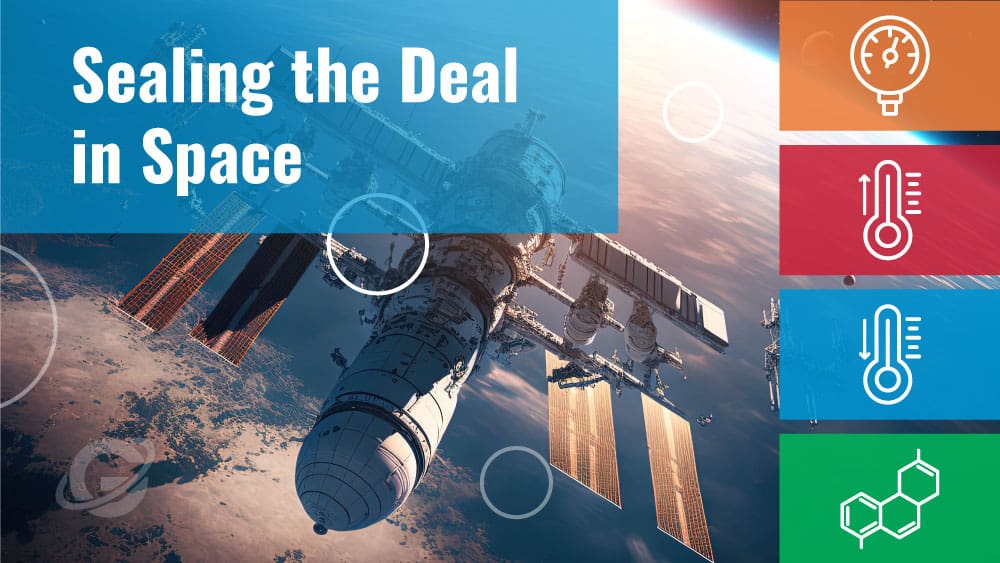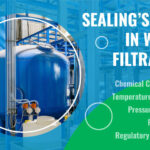
Summary
- Aerospace engineering relies heavily on specialized sealing solutions like o-rings and custom seals to ensure safe and efficient system operations in extreme conditions.
- Advanced materials such as Viton (FKM) and Teflon (PTFE) are pivotal for meeting the challenges of temperature, pressure, and chemical exposure in aerospace applications.
- As we venture into interplanetary travel and sustainable space habitats, the role of specialized seals and o-rings in aerospace applications continues to grow in significance.
Introduction
In aerospace engineering, the smallest components often carry the most significant responsibilities. Among these are o-rings, backup rings, x-rings, and custom seals. Their role may seem humble, but the science behind aerospace seals is as complex as it is critical. This post explores the unique challenges faced in this sector, reviews the criteria for material selection, discusses the specialized sealing solutions designed to meet the extreme demands of aerospace applications, and looks into the future of seals in space exploration.
The Unique Challenges of Sealing in Aerospace
The aerospace sector poses a complex set of challenges for sealing technology. Understanding these challenges is critical for selecting and engineering the most effective sealing solutions.
One of the foremost challenges in aerospace sealing is coping with extreme temperature variations. Seal material must withstand temperatures as low as -76°F (-60°C) in the stratosphere and as high as 599°F (315°C) in engine compartments. At these extremes, thermal expansion coefficients and the viscoelastic properties of seal materials can change drastically. Material selection, therefore, must be optimized for temperature resilience, and tests like the Thermal Gravimetric Analysis (TGA) are often employed to assess long-term thermal stability.
Aerospace applications are subject to intense mechanical stresses due to high speeds, rapid acceleration, and turbulence. These factors cause vibrations that can compromise the integrity of a seal. Fretting, a wear process induced by oscillating contact, is a common concern. Industry experts frequently use Finite Element Analysis (FEA) to simulate stress distribution and optimize seal geometries for maximum mechanical resilience.
Seals in aerospace applications often come into contact with aggressive chemicals like hydraulic fluids, fuel, and de-icing chemicals. These system environments require materials that offer excellent chemical and corrosion resistance. Performance tests such as Fourier Transform Infrared Spectroscopy (FTIR) assess chemical compatibility and ensure material integrity over extended periods.
In space, seals must perform in vacuum and low-pressure environments, posing challenges like outgassing and vacuum decay. The low outgassing properties of materials like Teflon and specific Viton (FKM) grades overcome this challenge in many applications. Vacuum compatibility tests are standard procedures to asses material stability for these conditions.
Lastly, strict regulations such as AS9100 govern the aerospace industry for quality management and various ASTM and MIL standards for material properties. Certifications like ISO 9001:2015 are often mandatory, and traceability of materials is crucial. Regulatory compliance not only dictates material selection but also influences the design and manufacturing processes of seals.

O-Ring Materials for Extreme Conditions
Selecting the appropriate o-ring material for aerospace applications involves complex considerations. These materials must fulfill specific performance metrics, withstand extreme environmental conditions, and meet strict industry standards. By understanding each material’s unique characteristics and applications, aerospace engineers can make educated sections to meet the industry’s stringent demands.
Criteria for Material Selection
- Temperature Resistance: Materials must perform at high and low temperatures, as the ability to withstand extreme thermal fluctuation without losing mechanical integrity is a strict requirement.
- Mechanical Strength: The material should possess high tensile strength, hardness, and toughness due to exposure to wear, tear, and deformation under mechanical stress.
- Chemical Compatibility: The material should not swell, degrade, or corrode in the presence of chemicals. It should resist chemicals commonly found in aerospace applications, including fuels, hydraulic fluids, and cleaning agents.
- Regulatory Compliance: The material must meet aerospace-specific standards like AS568, ASTM, or MIL specifications. This requirement includes quality control mechanisms and traceability.
- Elongation and Compression Set: The material must maintain its elastic properties over long periods, resisting permanent deformation when subjected to mechanical stress or temperature changes.
For more detailed information on various seal compounds, visit our compound page or chemical compatibility tool.
Common Materials
- Nitrile (NBR): Nitrile exhibits excellent oil and fuel resistance, good mechanical properties, and is cost-effective. It is often found in fuel and hydraulic systems where oil-based fluids are prevalent, making it ideal for lower-temperature aerospace applications.
- Viton (FKM): Viton is known for its exceptional high-temperature resistance and chemical compatibility. It is commonly used in jet engines and high-temperature hydraulic systems, making it an excellent choice for extreme thermal environments and chemically aggressive situations.
- EPDM: EPDM offers excellent ozone resistance, weather resistance, and a good temperature range of operation. It is frequently used for environmental seals and in pneumatic systems where ozone, UV, and weathering resistance are critical requirements.
- Silicone: Silicone is highly flexible and resistant to high and low temperatures. It is typically used in avionic controls and environmental seals, providing flexibility over various temperatures.
- Teflon (PTFE): Teflon is chemically inert, has a wide operating temperature range, and offers low friction. It is well-suited for chemical-resistant seals and high-temperature applications, offering broad resistance to industrial chemicals and solvents.
- Aflas: Aflas provides excellent chemical and heat resistance and robust mechanical properties. It frequently finds use in seals for aircraft chemical processing units and high-temperature aerospace applications.
- Other Specialized Materials: Engineers create custom compounds for specific needs, such as low outgassing in a vacuum or extreme mechanical strength. These find use in specialized aerospace applications like satellites or unique aircraft systems.
Seals in Aerospace Applications

The aerospace industry presents numerous unique challenges that necessitate specialized sealing solutions. O-Rings and other types of seals are pivotal in ensuring various aerospace systems’ safe and efficient operation. These critical components are responsible for withstanding extreme temperatures, pressure fluctuations, and corrosive chemicals.
Both o-rings and seals are vital in developing and functioning satellites and communication systems. The demanding conditions of space, including vacuums and extreme temperatures, require specialized materials like Viton (FKM) or Silicone. O-Rings often seal propulsion units, while custom-designed backup rings provide additional extrusion resistance. Without these sealing solutions, satellites could suffer system failures, jeopardizing critical global communication networks.
Jet engines use o-rings in components such as fuel injectors, turbine blades, and exhaust systems. O-Rings often seal high-pressure areas, while custom seals handle extreme heat and mechanical stress. Materials like Viton (FKM) and Aflas are preferred for their heat resistance and durability, ensuring the engine functions safely and efficiently.
Fuel systems in aerospace applications rely on both o-rings and specialized seals to maintain proper fuel flow and pressure. These components prevent fuel leaks and ensure system integrity during routine operations and emergencies. Buna (Nitrile) is often chosen for its oil-resistant properties, while custom Viton (FKM) seals find use in high-temperature environments. Correctly selecting both o-rings and seals is crucial for fuel systems’ safe and efficient operations.
In hydraulic systems used for flight-critical applications like landing gear and flight control surfaces, both o-rings and seals are essential. O-Rings generally provide the primary seal, while backup rings provide added reliability in high-pressure situations. EPDM or Teflon materials offer excellent chemical resistance against potentially corrosive hydraulic fluids. The combination of different types of seals ensures that these complex systems operate without failure, even under the most challenging conditions.
The Future of Seals in Space Exploration
As humanity pushes the boundaries of exploration beyond Earth’s orbit, the role of seals and o-rings becomes even more critical. The aerospace challenge of tomorrow will demand sealing solutions that are more advanced, reliable, and versatile than ever before.
The ambition to colonize Mars presents a plethora of challenges for sealing technology. Mars’ lower gravitational force, extreme temperature fluctuations, and dusty atmosphere necessitate materials and designs currently at the cutting edge of research. These seals would have to withstand long-term exposure to the Martian environment while maintaining a perfect seal to ensure the safety of inhabitants. The opportunity here lies in developing materials with self-healing capabilities or adaptive geometric properties.
Many expect moon bases to be the first step in our venture into deep space colonization. Unlike Earth, the Moon lacks an atmosphere, posing challenges like vacuum sealing and extreme temperature differentials between lunar days and nights. Seals in lunar bases would be integral in maintaining internal pressure, facilitating life support systems, and ensuring the effective operation of machinery in vacuum conditions.
As we venture further into space, the concept of orbiting space habitats or stations that mimic Earth-link conditions becomes more plausible. Seals will be vital in systems ranging from water recycling to air pressure maintenance. Material fatigue, radiation resistance, and long-term reliability are critical factors that engineers must consider when designing seals for these habitats.
The future of space exploration is moving towards sustainability, with plans for reusable rockets and equipment. This shift demands seals that can withstand extreme conditions and multiple cycles of use without significant wear and tear. Research is ongoing into materials that can be ‘refreshed’ in situ or even replaced using 3D printing technology on board spacecraft.
Innovations in material science, such as nanotechnology-infused materials, are likely to play a crucial role in the future of sealing technology. Adaptive materials, real-time monitoring of seal integrity, and smart seals equipped with sensors are among the numerous R&D prospects. Public and private investments in these technologies could expedite the realization of more durable, adaptive, and intelligent seals for space applications.
Conclusion
From Earth-bound jet engines to Mars-bound rockets, seals and o-rings play a pivotal role in aerospace engineering. These small but crucial components must adhere to stringent criteria regarding material properties, mechanical strength, and reliability to ensure the safety and success of countless aerospace applications. As technology propels us further into the cosmos, the next frontier in sealing solutions will undoubtedly bring new challenges that necessitate cutting-edge materials and innovative designs. As a cornerstone in this complex field, Global O-Ring and Seal is committed to providing specialized solutions that meet the industry’s demanding requirements. As we look forward to a future of interplanetary travel and sustainable space habitats, the significant role of these components becomes increasingly apparent, proving that even the smallest parts can have the most outsized impact.

 English
English  Español
Español  Français
Français  Português
Português  Deutsch
Deutsch  Italiano
Italiano  Русский
Русский  中文
中文  日本語
日本語  العربية
العربية  हिन्दी
हिन्दी 



